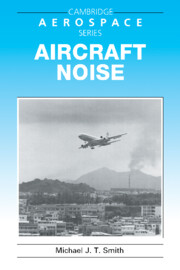Book contents
- Frontmatter
- Contents
- Preface
- Acknowledgments
- 1 Human reaction to aircraft noise
- 2 Action against aircraft noise
- 3 Aircraft noise sources
- 4 Power-plant noise control
- 5 Concorde – a special case
- 6 Noise data acquisition and presentation
- 7 Aircraft noise prediction
- 8 Prospects for the future
- 9 Review
- Appendices
- References
- Index
7 - Aircraft noise prediction
Published online by Cambridge University Press: 06 November 2009
- Frontmatter
- Contents
- Preface
- Acknowledgments
- 1 Human reaction to aircraft noise
- 2 Action against aircraft noise
- 3 Aircraft noise sources
- 4 Power-plant noise control
- 5 Concorde – a special case
- 6 Noise data acquisition and presentation
- 7 Aircraft noise prediction
- 8 Prospects for the future
- 9 Review
- Appendices
- References
- Index
Summary
Aircraft noise prediction involves two types of activities: predicting the noise of an individual aircraft and assessing the cumulative effect of the complex pattern of operations in and out of a specific airport. The latter depends on the former for a wide range of aircraft types.
Aircraft noise
Without available direct measurements, the only method of assessing the impact of a completely new aircraft or power-plant design is to utilise a reliable prediction procedure. Such a procedure may be able to make use of a limited amount of directly relevant data, for example, engine test data where a development programme is under way, or it may have to rely entirely upon empirical component prediction procedures. The latter situation arises at the advanced project stage of any new aircraft design – a current example could be an aircraft with propfans or a second-generation supersonic transport with a novel variable-cycle propulsion system concept.
To be successful, aircraft noise prediction must be based on a reliable definition of aircraft performance and a confident prediction of the noise characteristics of the power-plant (as a function of power setting, altitude and flight speed). Where there are substantial and related measured data to support a new concept, their projection to the new aircraft situation can follow fairly well-defined routes. For example, if the new aircraft incorporates power-plants that are not much different from versions already in service, flight test data can be transposed fairly simply to a new situation. Where the measured information is obtained from static engine tests during the development programme, methods are being established for transposing these data to the flight situation.
- Type
- Chapter
- Information
- Aircraft Noise , pp. 227 - 245Publisher: Cambridge University PressPrint publication year: 1989



